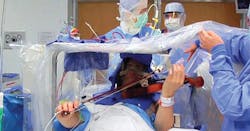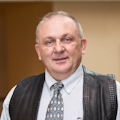Femtosecond laser system produces brain probes for use in awake brain surgery
ROCHESTER, MN - Awake brain surgery (ABS) is used to perform many operations on the brain while the patient is awake because it is easier to affect certain outcomes if the feedback is instantaneous. There are patients who absolutely refuse to be awake—but for the ones who are game, ABS offers some major advantages. In most cases, the precision of the operation is much better, so the outcome is more predictable. Perfect candidates for ABS are those with problems located very close to sensitive areas of the brain, where the surgeon can investigate consequences before tissue removal or other intrusive procedures. Recently, an interesting interview on TV with Dr. Bernard Bendok of the Mayo Clinic (Rochester, MN) discussed this technique (see https://youtu.be/3A2MLbAs_FU).
I found it interesting because I am personally aware and somewhat involved in a subset of ABS called deep brain surgery (DBS), which is being pioneered at the Mayo Clinic by Dr. Kendall Lee and his team. In this technique, a long electrode is inserted deep into the brain and electrical stimulation is used to stimulate the affected area. A beautiful example is the operation performed on Roger Frisch, a professional violinist, who had tremors bad enough that it affected his ability to play at a concert level and whose career might have been over if not for the surgery (FIGURE).
So, what does this have to do with industrial lasers? Simply, a femtosecond laser system built by PhotoMachining (Pelham, NH) is being used at the Mayo Clinic to manufacture the brain probes. This three-wavelength system (infrared [IR], visible, and UV) uses a Light Conversion Pharos laser with pulse length of about 300fs and is used to manufacture a variety of different devices, including the probes. While the laser system was purchased initially to work on these probes, involving structuring parylene on the probes without compromising the underlying substrate, other medical researchers expressed interest in using the tool for other things. In addition to the parylene, the UV wavelength has been used for cutting and drilling polyimide, the IR wavelength has been used (with a rotary stage) for cutting slots and drilling holes in different metal tubes, and the visible wavelength has been used for structuring thin films on glass. The laser also has an Aerotech stent lathe capable of making both metal and bioabsorbable stents.
The Neural Engineering Laboratory is run by Dr. Lee (Director) and Kevin Bennet (Co-Director and Chair of the Division of Engineering). Dr. Lee is responsible for the strategic leadership of the lab, oversight of all lab research, and mentoring junior faculty and students. He also performs all of the human neurosurgery procedures conducted as part of the lab's research studies. The Division of Engineering builds custom medical systems and devices to enhance patient care and advance research. It has engineers and technologists in biomedical, electrical, software, mechanical, and chemical engineering specialties, as well as a prototype shop (also including a CO2 laser system) and a custom glass-blowing facility. For more information, please visit www.mayoclinic.org.
About the Author
Ron Schaeffer
Ron Schaeffer, Ph.D., is a blogger and contributing editor, and a member of the Laser Focus World Editorial Advisory Board. He is an industry expert in the field of laser micromachining and was formerly Chief Executive Officer of PhotoMachining, Inc. He has been involved in laser manufacturing and materials processing for over 25 years, working in and starting small companies. He is an advisor and past member of the Board of Directors of the Laser Institute of America. He has a Ph.D. in Physical Chemistry from Lehigh University and did graduate work at the University of Paris. His book, Fundamentals of Laser Micromachining, is available from CRC Press.


